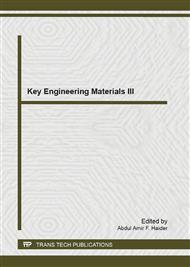p.98
p.103
p.108
p.115
p.120
p.125
p.131
p.136
p.141
Electrical Properties of Starch Based Silver Ion Conducting Solid Biopolymer Electrolyte
Abstract:
In the present study, the electrical and dielectric properties of a solid biopolymer electrolyte system based on starch doped with different amounts of silver nitrate (AgNO3) were analyzed. The electrolyte system was prepared via solution cast technique. Electrical impedance spectroscopy (EIS) measurement for the system was conducted over a frequency range of 50 Hz - 1 MHz at room temperature. It was found that the sample containing 6 wt.% AgNO3 obtained the highest conductivity value of 1.03 × 10-9 S cm-1. The effect of salt concentration on the dielectric properties of the electrolytes was also studied in relation to the conductivity properties. The dielectric studies indicated that the electrolytes in the present study obeyed non-Debye behavior.
Info:
Periodical:
Pages:
120-124
Citation:
Online since:
May 2013
Authors:
Keywords:
Price:
Сopyright:
© 2013 Trans Tech Publications Ltd. All Rights Reserved
Share:
Citation:


